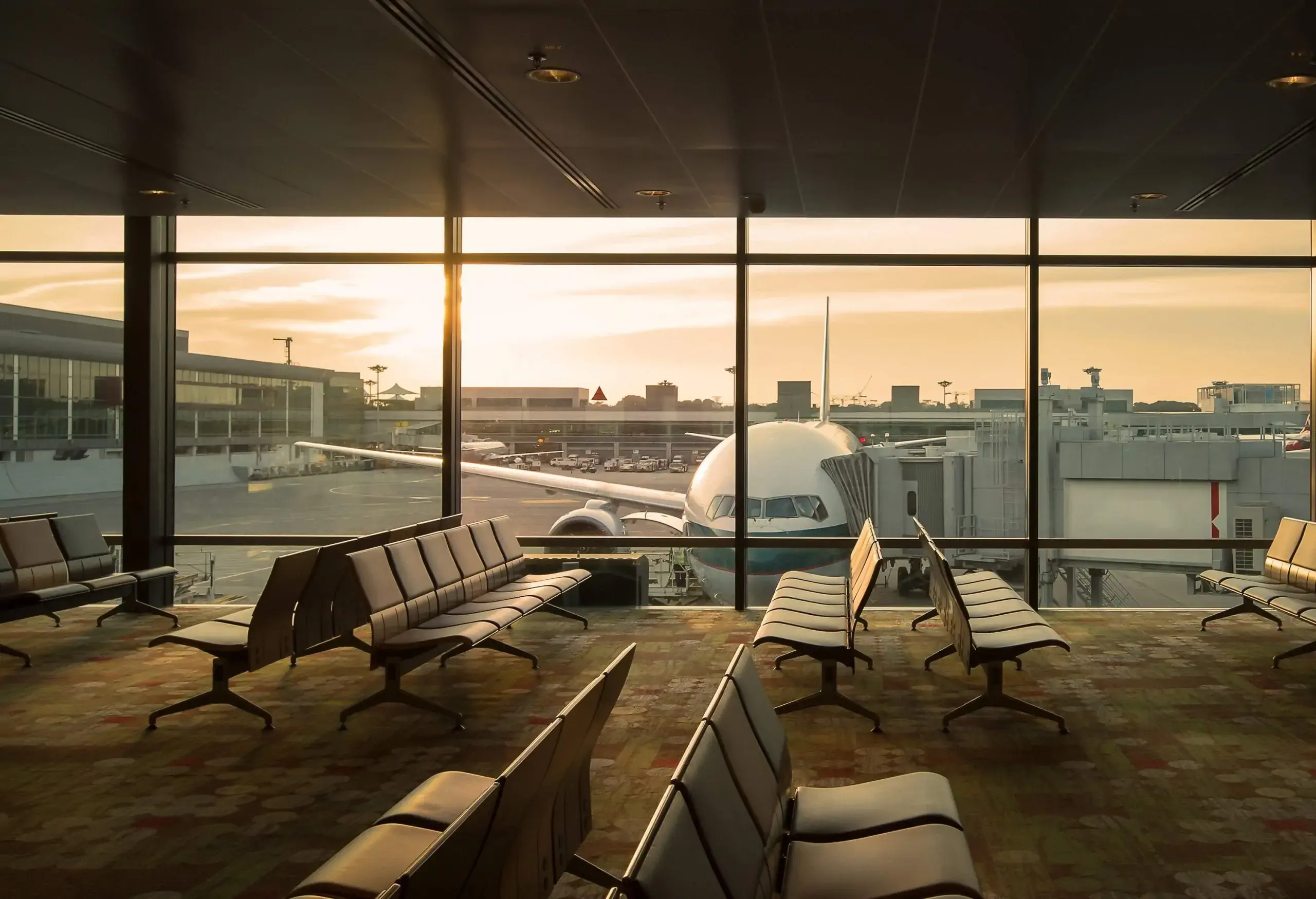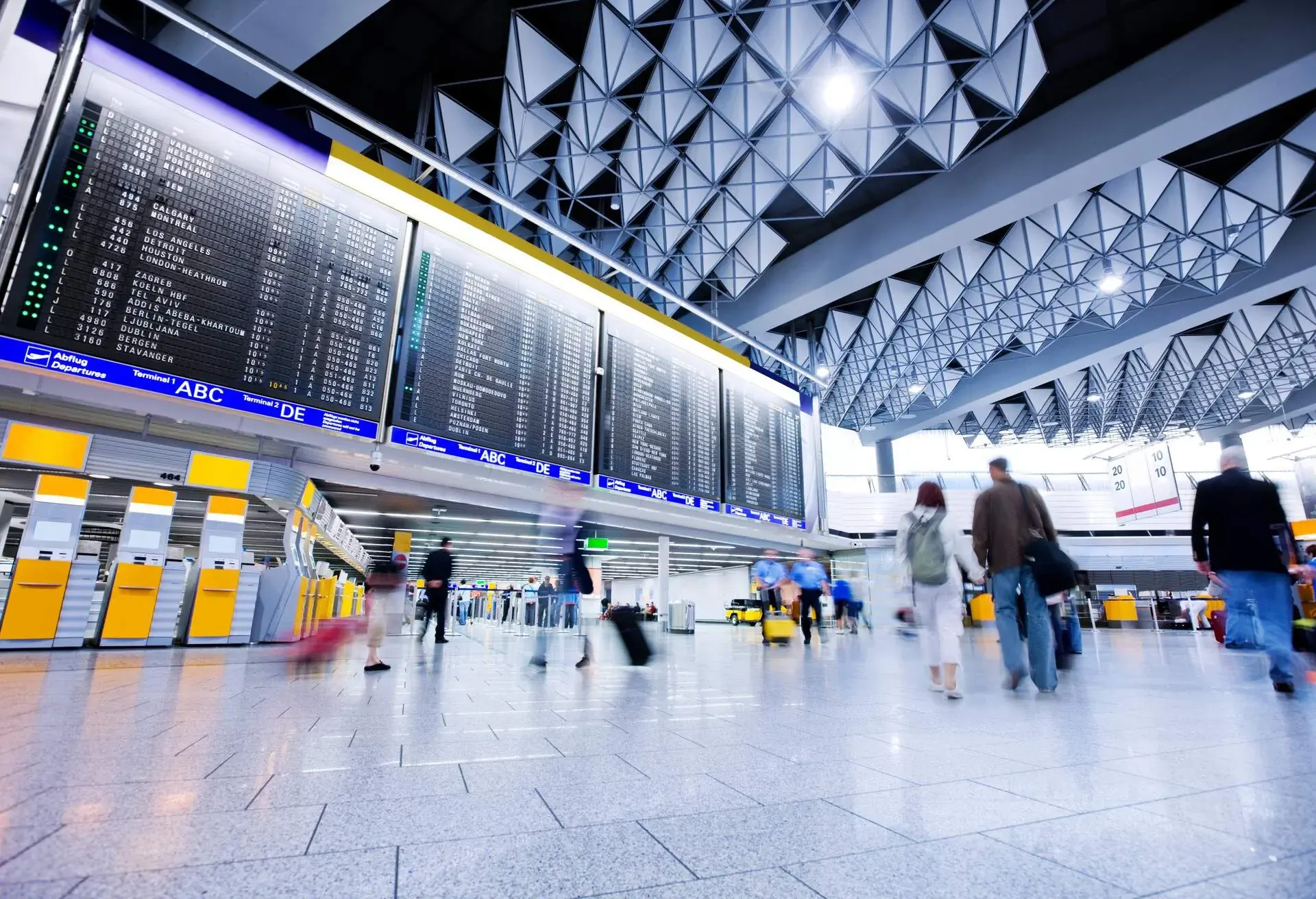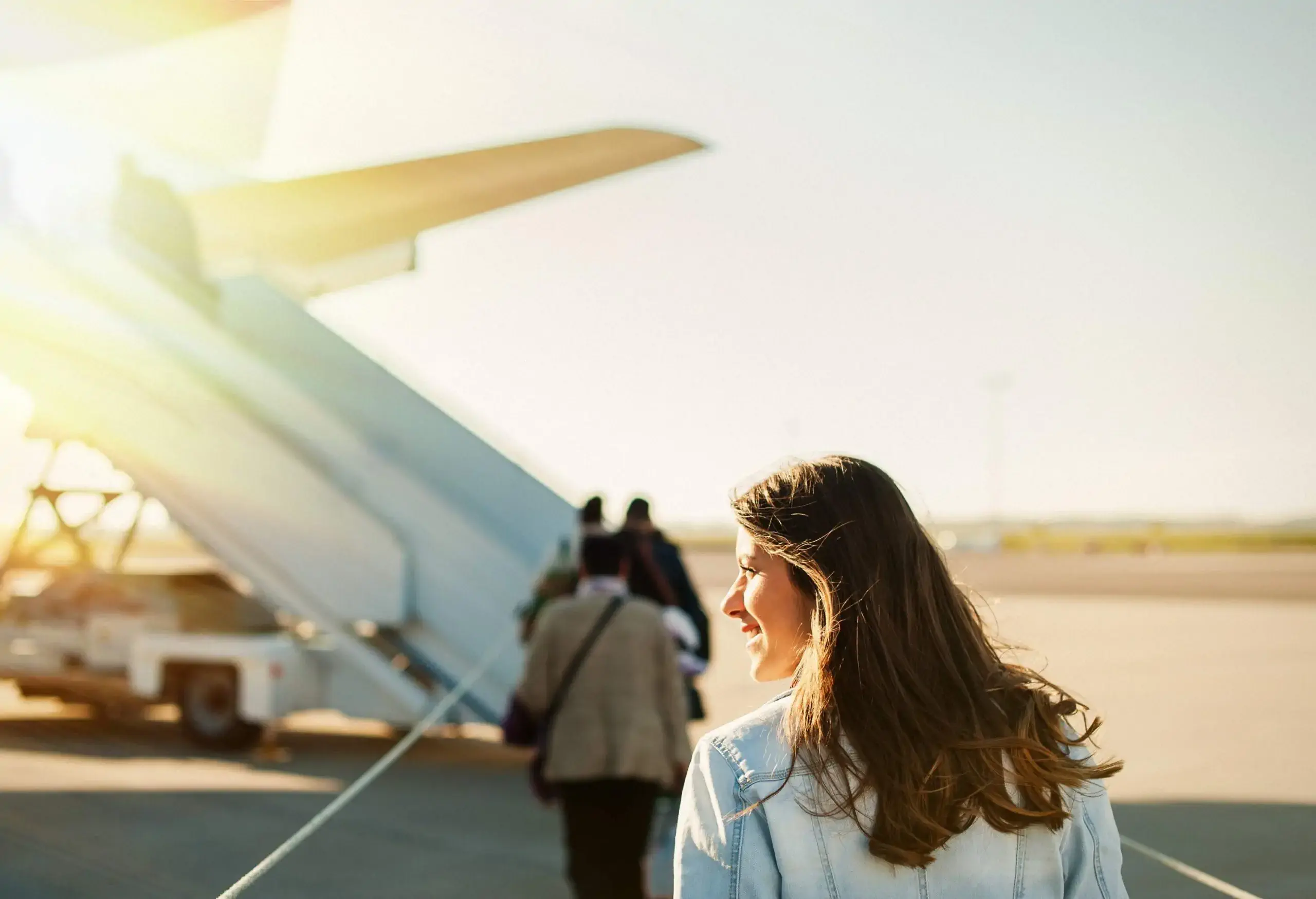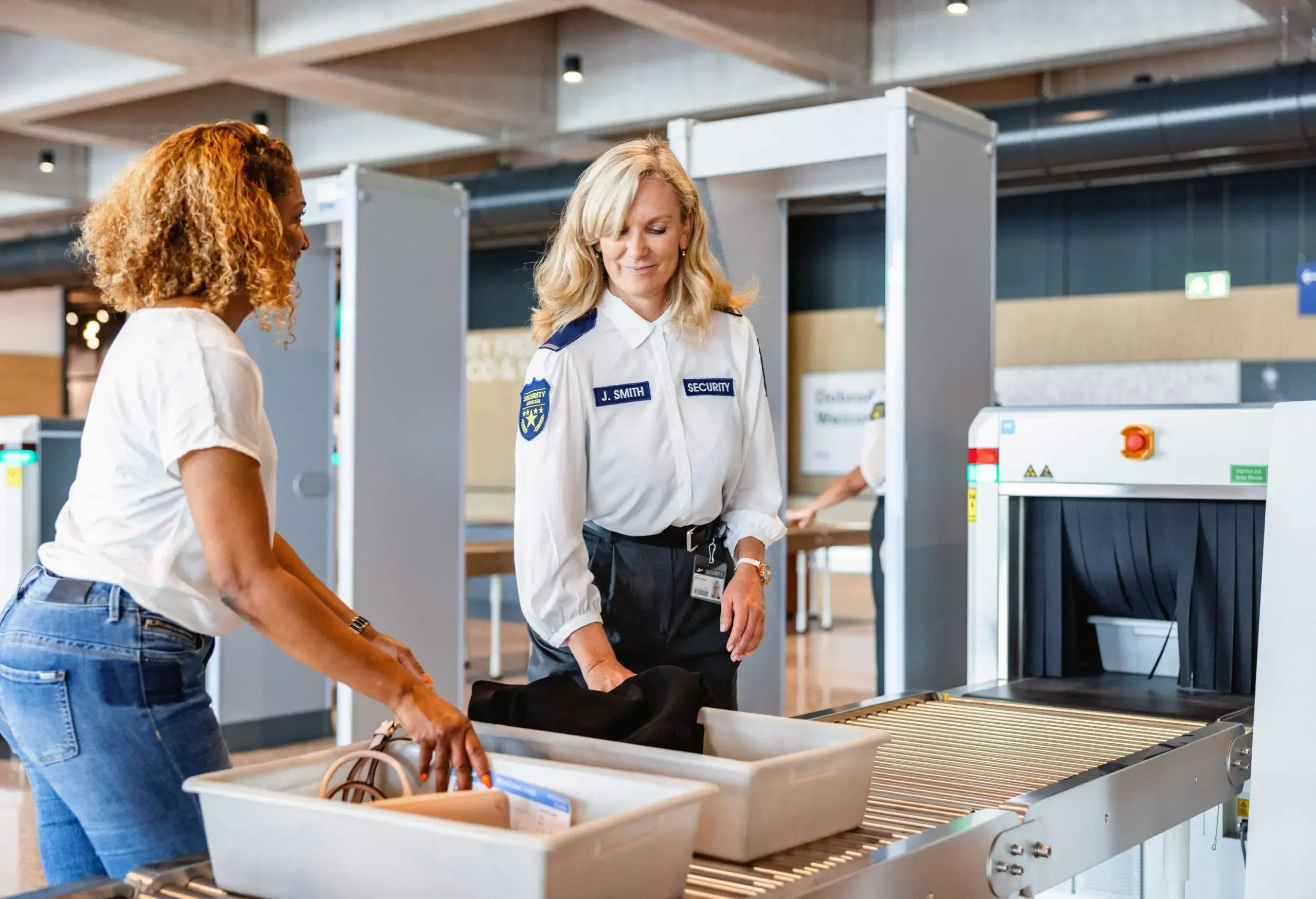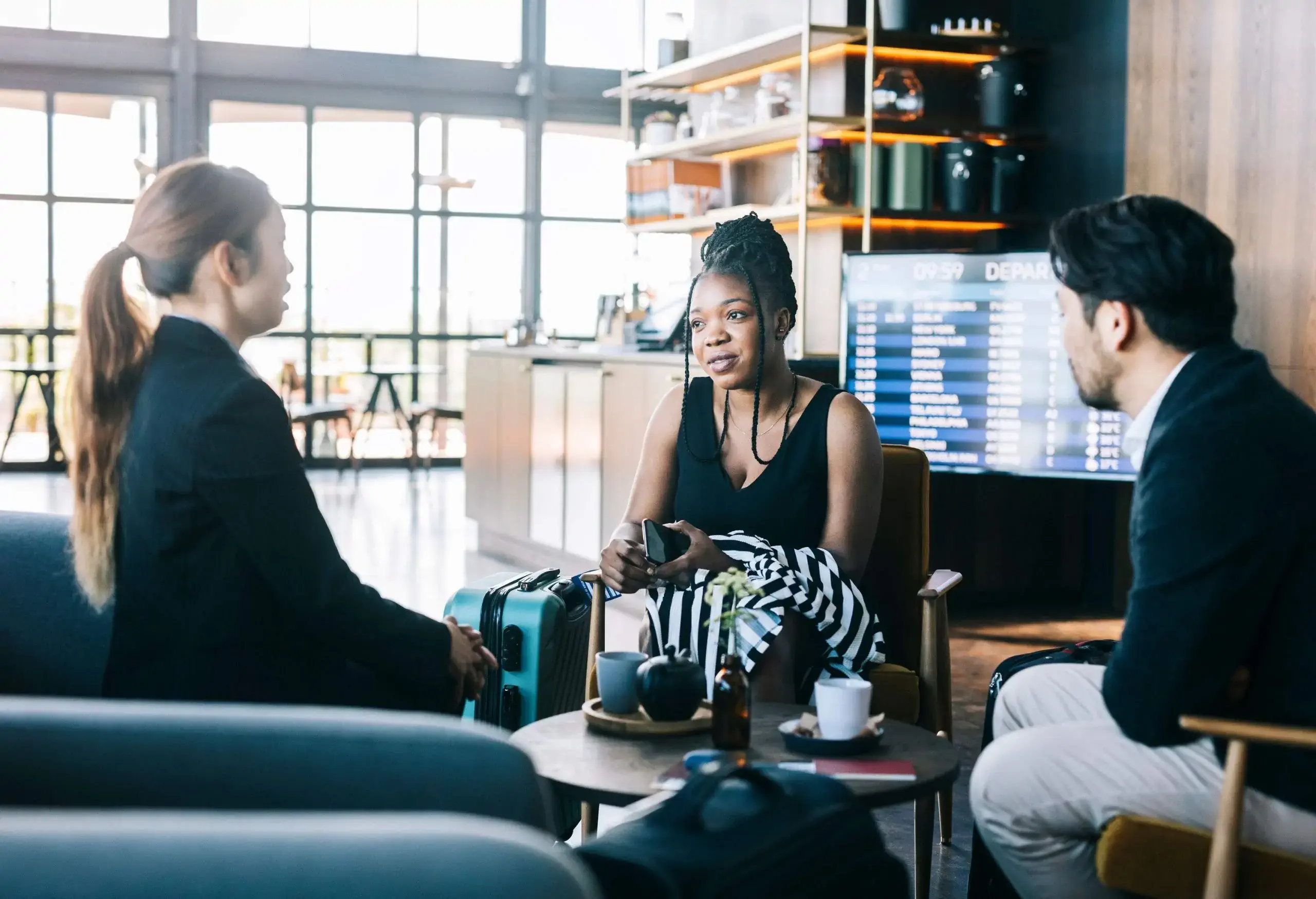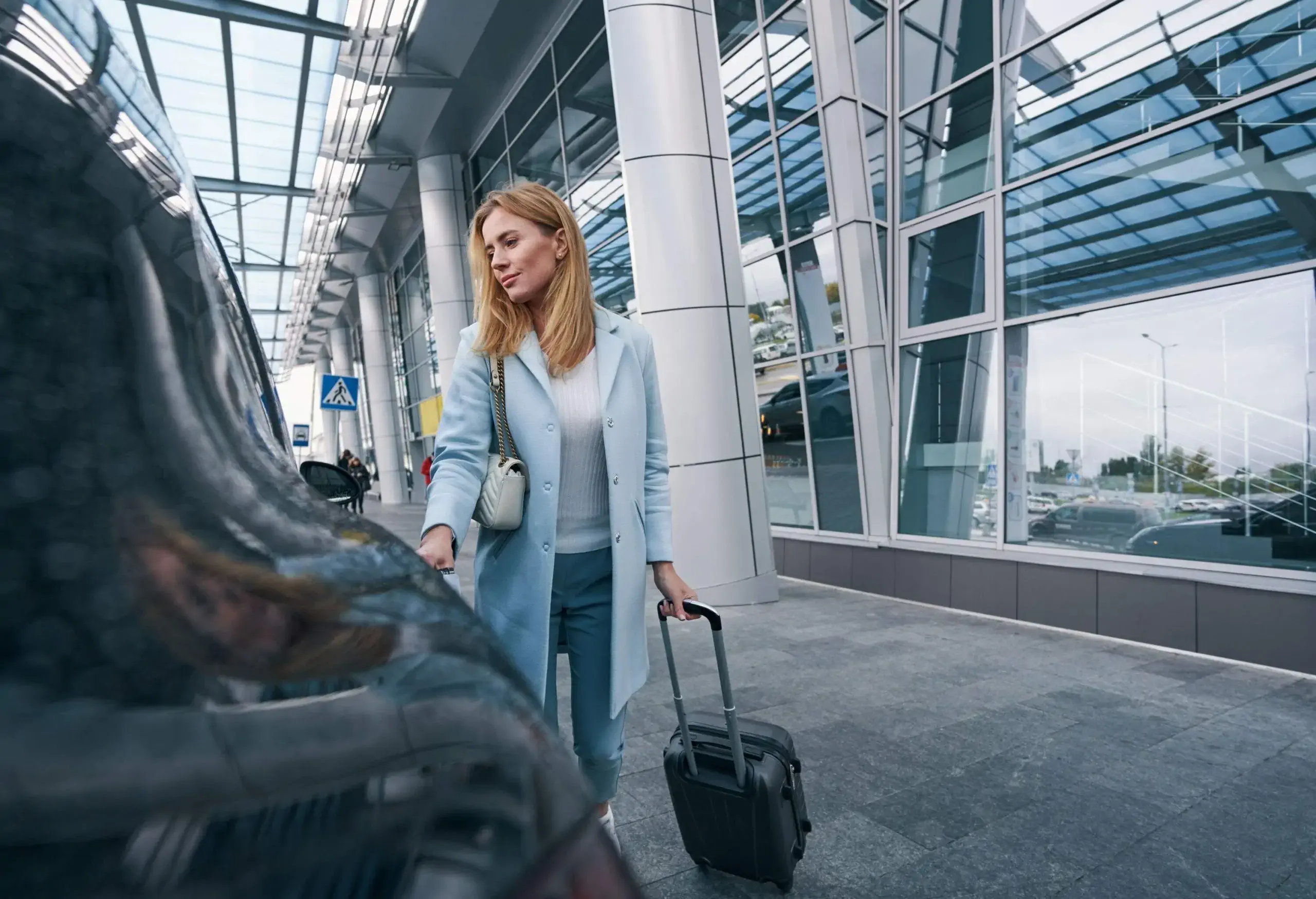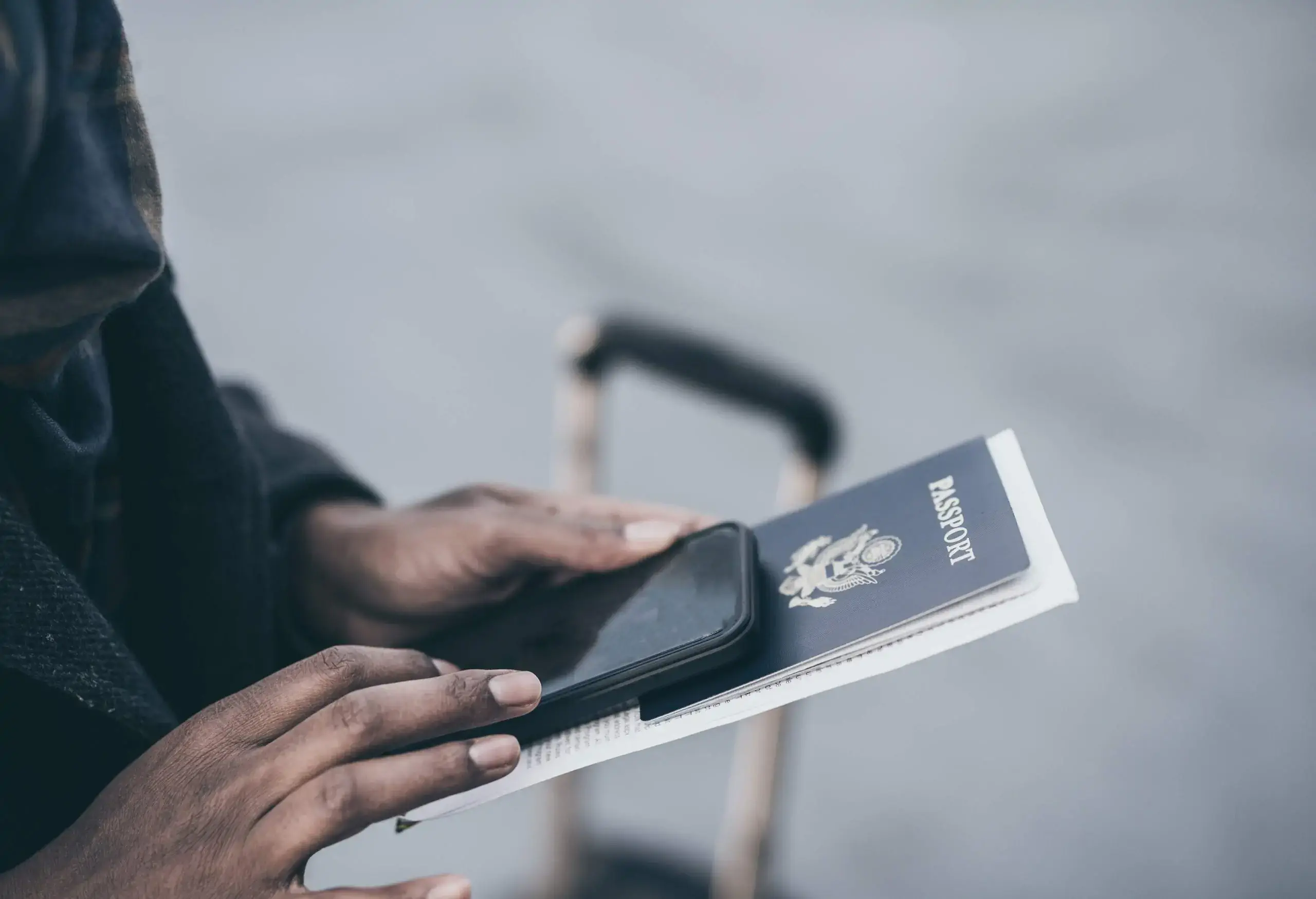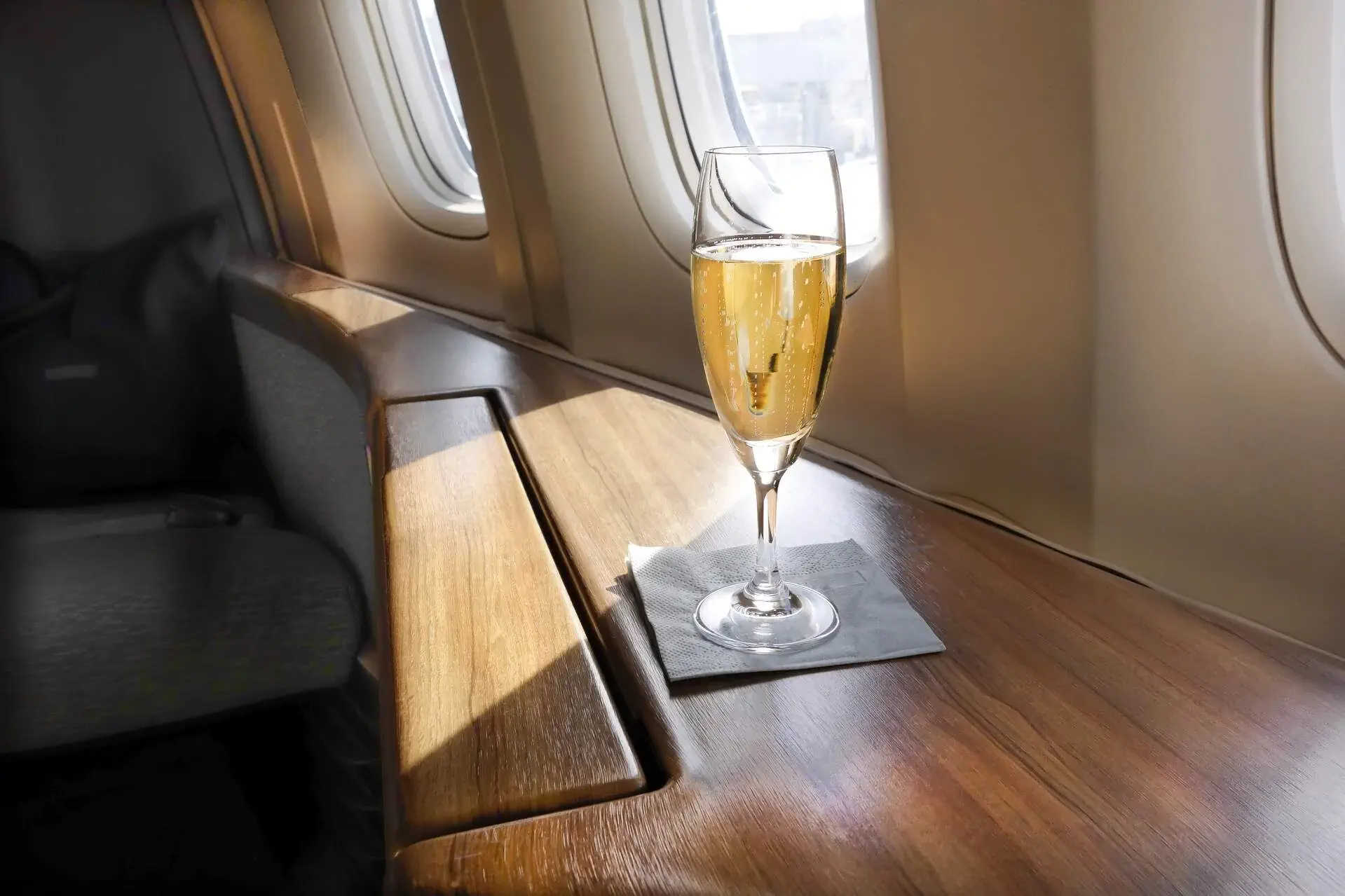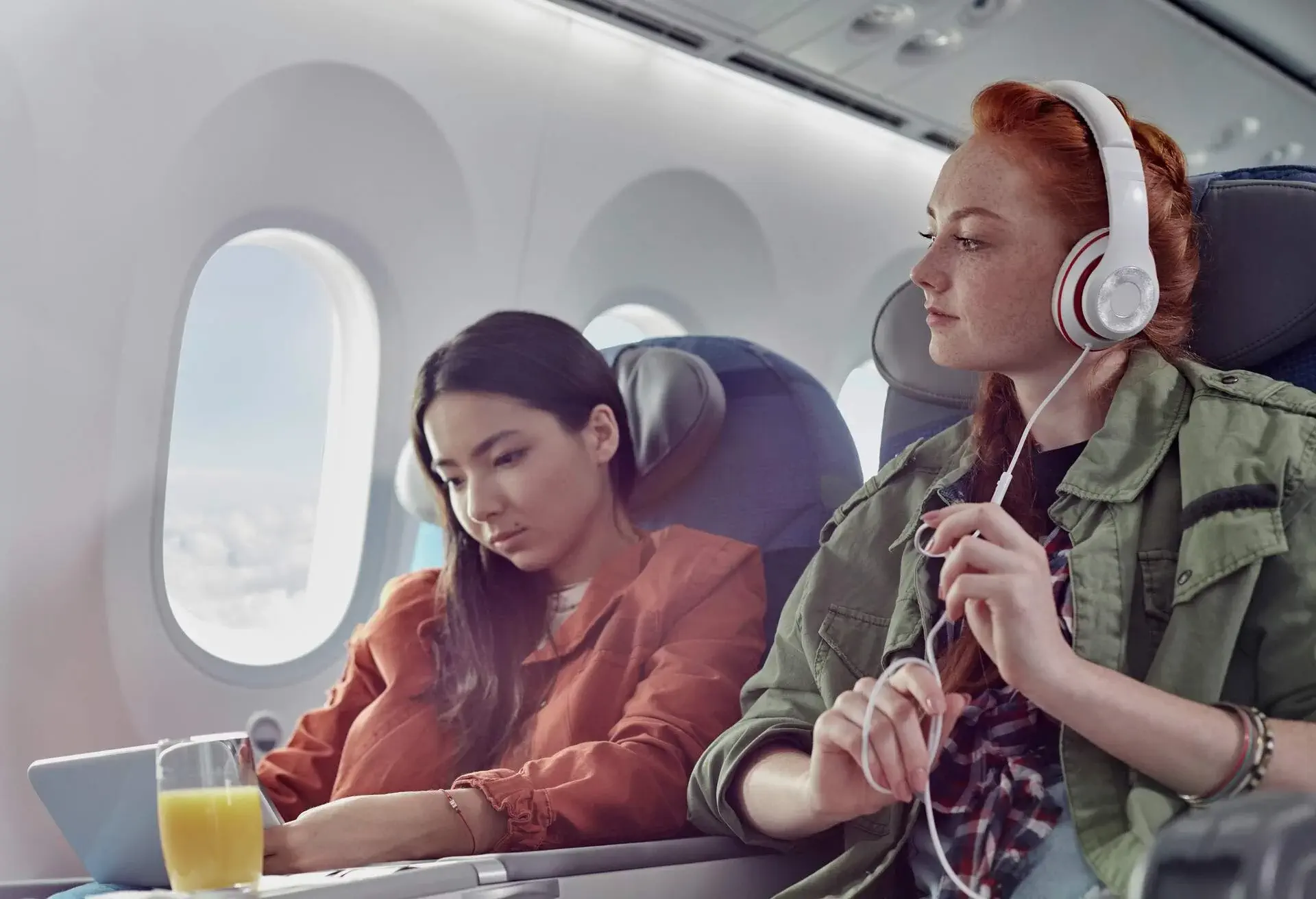No need to worry about whether you'll make your connecting flight in time or might miss your check-in. We've asked our travel experts to answer travelers' most common airport questions, so you can breeze through your next airport experience.
Airport tips to get you on your way.
Getting through the airport can be a harrowing experience if you don't have the right moves. Read through these suggestions and arrive ready to enjoy your airport layover.
Airport aprons
From inside most airports, you can look out from banks of windows and see airplanes lined up at the gates and lots of busy workers on the ground. There are aircraft jet bridges being rolled into position and pulling away from full planes. Passengers are boarding and deboarding. Baggage handlers are loading and unloading suitcases. Planes are being refueled and inspected.
And it’s all taking place in the areas of the airport officially called aprons. You’ll often hear those areas referred to as ramps. And, according to the Federal Aviation Administration both terms are used to describe “the areas where aircraft park, load and unload.” But the official term is aprons.
Airport aprons are distinct from runways, which are where planes take off and land. And aprons are different than airport taxiways, which are the roadways, or the off and on ramps, that planes travel along to get to and from the runways.
What about the tarmac? Tarmac is the registered and trademarked product name of the material used to pave airport runways and other surfaces. And, technically, there is no specific area of an airport call the tarmac. But, that doesn’t deter travelers, news reporters and even the U.S. Department of Transportation from using the term tarmac when describing the activity that takes place on the airport apron. In fact, the DOT’s rule and schedule of fines for airlines at U.S. airports that don’t provide passengers with water, snacks or the opportunity to deplane during extended delays before takeoff or after landing is called, you guessed it, the “tarmac delay” rule.
Airport codes
BWI. SEA. LAX. ORD. You’ll notice letter codes like these on your airline flight reservations, on your boarding passes, on your checked bag tags, on airport and airline websites and, sometimes, on caps, mugs, socks and other swag handed out at airports.
These letter codes are official airport codes. And most every commercial airport in the world, large or small, has a unique three-letter code assigned to it by the International Air Transport Association (IATA) as well as a four-letter code assigned by the International Civil Aviation Organization (ICAO). The codes are a sort of shorthand system used to distinguish one airport from another and it is IATA’s set of 3-letter codes that you’ll regularly see and use during your travels. Pilots and air traffic controllers use the four-letter ICAO codes.
Many three-letter airport codes are clearly linked to their city. Think, DEN for Denver International Airport and ALB for the airport in Albany, New York. Others get their code from the airport’s namesake. So, the code for New York’s John F. Kennedy International Airport is JFK and the code for the Paris Charles de Gaulle Airport is CDG.
And then there are the airport codes that spell out words and/or elicit a giggle. The code for California’s Fresno International Airport is FAT. Florida’s St. Pete-Clearwater International Airport’s code is PIE. And although they once tried to swap it out for something else, the folks at Iowa’s Sioux Gateway Airport now fully embrace their IATA code, which is SUX. Curious about the code for an airport you’re visiting? You can look it up by name or code on the IATA website.
Airport gate
At the airport, the area where you wait to board your flight is called the gate, boarding gate, or hold room. You’ll find the assigned gate number for your flight on your boarding pass or posted on the flight information screens in the terminal. In large airports, the trek from the main terminal to your gate might be a 15-to-20-minute walk, so make sure to recheck the gate assignment before heading that way.
In the gate area you’ll usually find an information board with details about your flight, including the scheduled boarding and departure time. Messages about seat assignments, delays, and other flight details may be posted here as well.
Gate agents will arrive at the gate 45 minutes to an hour before the flight to staff the counter and take care of a myriad of flight details, including finalizing seating for upgraded and standby passengers, answering questions, and getting all the passengers onto the plane for a, hopefully, on-time departure.
In many airports, the gate areas are simply rooms or open spaces off the concourse corridor with hard seats. So, you may want to spend most of your pre-flight time in the shops or restaurants nearby. Elsewhere, gate areas are more welcoming, with comfortable worktables and banks of lounge chairs, plenty of places to charge phones and gadgets, museum-quality artwork, great views to the airfield, and the option to have meals and drinks, even cocktails, delivered to your seat.
Airport security check
Before you can board a commercial flight in the United States (or any country), you, your checked luggage and any carry-on items you want to take with you on the airplane must go through an airport security check.
In the United States, airport security is overseen by the Transportation Security Administration (TSA). This government agency is tasked with preserving transportation security on mass transit systems (and at ports) and with preventing prohibited items from entering the sterile, or post-security, areas of airport terminals. TSA screens checked baggage in secure areas at airports using state-of-the-art X-ray scanning equipment. Similar technology is used at the security checkpoints, where you and your carry-on items will be screened for prohibited or dangerous items, such as weapons and explosives.
In the standard screening lane, you’ll need to empty your pockets before going through the screening machinery, put your shoes on the x-ray belt, and place liquids that comply with TSA’s 3-1-1 rule and all electronics in trays or bins. If you’re signed up for TSA PreCheck, you must still empty your pockets, but you are allowed to keep your shoes on and send your carry-on bag through the x-ray machine with electronics and liquids inside.
Airport security programs
Hate to wait at the airport? There are airport security programs that will cut the time you spend at the checkpoint before your flight and on the customs and immigration lines after international flights when you come home.
TSA PreCheck gives low-risk travelers access to dedicated Transportation Security Administration (TSA) checkpoint lanes at more than 200 airports. No need to remove your shoes, electronics, 3-1-1 liquids or light jackets. The application process includes a visit to an enrollment site to get fingerprinted and photographed, plus a $78 fee, which covers a five-year membership (renewal is $70.)
Clear ($189/year), available at more than 55 airports, uses biometric data (fingerprints and/or eye scans) to identify vetted members. If you’re enrolled in TSA PreCheck, you’ll get escorted to the front of the TSA PreCheck lanes; if not, you’ll go to the front of the standard TSA line.
Clear also manages Reserve, a free program offered at more than 20 airports in North America and Europe that allows travelers to avoid long airport security lines by making a reservation to go through a dedicated standard TSA lane at a certain time.
Global Entry, a U.S. Customs and Border Protection program, offers expedited entry lanes for vetted travelers at dozens of U.S. airports and at land and sea borders via the NEXUS and SENTRI programs. Membership is $100, includes TSA PreCheck and is good for 5 years.
Airport terminal
At an airport, the terminal is the building or collection of buildings where airline passengers go to board planes and where arriving passengers deplane. The airport terminal is also where passengers may check-in for their flights (if they haven’t done so on-line), drop off their luggage, pass through security and wait at gate holding areas for their flights to depart.
And the terminal is where arriving passengers pass through customs and immigration (if arriving on an international flight), retrieve checked luggage at baggage claim, and proceed to private or public ground transportation or into the arms of friends or family waiting in the arrivals area or curbside.
Small airports usually have one main terminal with a handful of boarding gates. Larger airports may have a main terminal with boarding gates stretched out along several corridors, or concourses. There may also be separate ‘satellite’ terminals accessed by walkways, trains, or buses. No matter the size, in addition to check-in and boarding gates and airline counters, airport terminal buildings have shops, restaurants, bars, kids play areas, restrooms, and other amenities.
Airport transfer
Airport transfers include a variety of shared, private and scheduled services providing transportation to or from the airport and locations such as hotels, cruises, ships, event venues, and homes.
While convenient, public transportation and taxis or popular rideshare services are not categorized as airport transfers. Services that range from hotel shuttle vans to private car services are.
Private airport transfers
Those people standing in the bag claim arrivals hall holding handwritten signs or electronic screens with people’s names on them are drivers hired to provide pre-booked airport transfers, usually in town cars or swanky limousines. You can pre-book this type of airport transfer from your home to the airport as well. While more expensive than public transportation and, usually, hailed taxis or rideshares, this sort of airport transfer is popular because it is dependable and convenient.
If you’re joining a tour group or cruise, the company you’ve booked with may include or offer to arrange an airport transfer in a town car, van or bus as well.
Shared airport transfers
Shared bus or shuttle van service is another airport transfer option. You can reserve a ride to the airport in a shared van that picks up other passengers along the way. And at the airport, you can book a seat in a shared van that will drop passengers off at their homes or another in-town destination.
Shared airport transfers include the complimentary hotel shuttle vans often offered by hotels at or near airports. Most operate with a regular curbside pick-up schedule. Others require that you call the hotel from bag claim to request a pick-up, especially in off-hours. Note that some hotels, especially near busy cruise ports, offer their shared van service to and from the airport or the port for a fee.
Baggage claim
The baggage claim, sometimes referred to as the baggage hall, is the area of an airport where passengers on arriving flights go to reclaim checked luggage that has traveled in the hold of the airplane.
In all but the smallest airports, unloaded bags are delivered from the airplane to rotating conveyor belts known as baggage carousels, or luggage carousels, in the baggage claim area. You watch for your bag to appear on the moving conveyor and pluck it off as it moves by. Fellow passengers may crowd the belts, but the proper carousel etiquette is to stand back until you spot your bag and then move forward to retrieve it. The handy thing about a carousel is that if you miss your bag the first time, it will come around again.
How will you know which carousel will have your luggage? A flight attendant or gate agent meeting your flight may announce the number, or letter, of the assigned bag claim carousel. Your airline’s app may send you an alert. Or follow the signs to baggage claim and scan the display boards for your flight number, origination city, and luggage carousel number.
And how long will it take for your bags to arrive at the bag claim? The cheeky answer is ‘it depends.’ While it may sometimes feel as if it’s taking forever for your bag to arrive, technology has made it easier for airlines to get your baggage off the plane and to the bag claim. In fact, at least two airlines, Alaska and Delta, offer a 20-minute bag service guarantee (conditions apply) and both offer compensation if they don’t deliver your bags on time.
Boarding a flight
Boarding a flight is the process of moving from the waiting area at the gate and onto the airplane. You will need a boarding pass to board a flight. If you check in online, your airline will issue an electronic boarding pass that can be printed or stored on a smartphone. Printed boarding passes can also be secured at the airport from self-service kiosks or at your airline’s ticket counter. Once you pass through the security checkpoint, you may head to the gate assigned to your flight. To find the gate number, look on your ticket or on the airport information display screens.
Domestic flights usually start boarding about 30 minutes before departure. International flights begin boarding 45 minutes to an hour before departure. Most airlines close boarding at least 15 minutes before departure. And while the plane may still be at the gate with the door open, you may be denied boarding if you are late.
Airlines board flights by zones, groups, rows, or seats. And, for efficiency, passengers are asked to only approach the jetway entrance with their assigned group. First and business-class passengers usually board first, followed by premium and economy class passengers. But airlines often offer early boarding to parents traveling with small children, people who need help boarding, active military personnel and others.
When it is your turn to board, scan or show your boarding pass to the gate agent at the jet bridge door, follow the walkway to the airplane door, find you row and seat number on the plane, store your bags overhead or under your seat and settle in for your flight.
Check-in
Checking in for your flight can be as easy as making a few taps on an airline app or it may require you to stand in line at the airport check-in counter. Either way, you must check in for your flight before the airline will issue you a boarding pass. And if you don’t check in on time, you will not be allowed to board your flight. Checking in for your flight can be as easy as making a few taps on an airline app or it may require you to stand in line at the airport check-in counter. Either way, you must check in for your flight before the airline will issue you a boarding pass. And if you don’t check in on time, you will not be allowed to board your flight.
Checking in for your flight can be as easy as making a few taps on an airline app or it may require you to stand in line at the airport check-in counter. Either way, you must check in for your flight before the airline will issue you a boarding pass. And if you don’t check in on time, you will not be allowed to board your flight.
Checking in for your flight can be as easy as making a few taps on an airline app or it may require you to stand in line at the airport check-in counter. Either way, you must check in for your flight before the airline will issue you a boarding pass. And if you don’t check in on time, you will not be allowed to board your flight.
Customs & immigration
Arriving international travelers must show their passports and go through a customs and immigration checkpoint before they leave the secure area of an airport. Arriving international travelers must show their passports and go through a customs and immigration checkpoint before they leave the secure area of an airport.
Arriving international travelers must show their passports and go through a customs and immigration checkpoint before they leave the secure area of an airport.
Arriving international travelers must show their passports and go through a customs and immigration checkpoint before they leave the secure area of an airport. Arriving international travelers must show their passports and go through a customs and immigration checkpoint before they leave the secure area of an airport.
Hub airport
It would be great if you could fly non-stop from your home airport to any destination your heart desires or your business trip requires. And indeed, some big airports boast that they offer more than 200 nonstop flights to domestic and international destinations.
But, for efficiency, most airlines operate on a hub and spoke system with key airports serving as the hubs, or main connecting points, for a network of flights that come and go from other cities on routes that serve as spokes. So, unless you live by a big airport and their nonstop destinations are on your agenda, you may find that you must connect, or transfer, in a hub airport before getting where you need to go.
Depending on your destination, the time between flights may be less than an hour or require a multi-hour layover. And frequent flyers will get to know certain hub airports very well.
One or more airlines may use an airport as a hub, and major airlines operate with hubs at multiple airports. American Airlines has its largest hub at Dallas Fort Worth International Airport (DFW) and additional domestic hubs in Charlotte, Chicago, Los Angeles, Miami, New York, Philadelphia, Phoenix and Washington, D.C.
Delta Air Lines’ main hub is at Hartsfield-Jackson Atlanta International Airport (ATL), but it also maintains domestic hubs in Boston, Detroit, Los Angeles, Minneapolis-St. Paul, New York (JFK and LaGuardia), Salt Lake City and Seattle. And United Airlines’ domestic hubs are Chicago (O’Hare), Houston, Los Angeles, Newark (EWR), San Francisco, and Washington (Dulles).


Travel experts dish their best secrets.
Discover the most effective hacks for making your airport-to-airport journey smooth and enjoyable – from travel industry heavyweights Harriet Baskas, Stefanie Waldek and Blane Bachelor.
1. Preparing for a layover
If your airport layover is short, study the airport terminal map before landing so you won’t stumble around searching for your next flight’s gate. During a layover of a few hours, you may be tempted to park yourself in one spot.
You’ll have more fun if you review the airport’s website (or visit an information desk) and treat yourself to a nice sit-down meal, an in-airport art tour, a day pass to a lounge, or some private work or nap time in a short stay airside hotel.
You might also visit an airport yoga studio, an outdoor observation deck, or a spa offering massages, manicures and other salon services.
2. Airport security hack
Airport security isn’t always the most pleasant experience, but it is possible to make it easier. I recommend signing up for TSA PreCheck. Most airports have special lanes for members of this Trusted Traveler program, which is run by the Transportation Security Administration, and they’re almost always shorter than the regular airport security lanes. TSA PreCheck members also do not need to remove their liquids, electronics, or shoes as they’re going through security.
You can also get TSA PreCheck for free if you sign up for Global Entry, which is a Trusted Traveler program for expediting immigration into the U.S. There’s also the private company Clear that allows you to skip the airport security line, though it’s far more expensive than TSA PreCheck, and in my own experience, the lines aren’t necessarily all that short these days. Still, you might be able to get a free or discounted Clear membership via certain credit cards and airline loyalty programs. Finally, if you don’t belong to any of these programs, you can still make your airport security experience easier.
3. What to wear at the airport
Many travelers put a lot of thought into what they’ll wear for a long flight. But one of the tips among my best airport hacks is to make sure you also dress for the airport before even boarding a flight.
First off, if you (like me) prefer not to check a bag whenever possible, you can save space in your carry-on by wearing an extra layer or two. One essential for nearly every trip I take is my denim jean jacket. The perfect blend of fashionable and functional, it goes with just about any outfit. But its pockets are my airport’s secret weapon, specifically the two inner ones. They’re ideal for stashing must-haves like boarding passes, phones, and passports.
That convenience is great for the flight too: easy to take off when you’re at your seat, a cinch to pull back on when you need to use the restroom or stretch your legs.
More guides for happy travels.
Flight status info, airport maps and other info for popular airports.
Disclaimer: Information is correct as of 03.14.2024 and may vary with time.

